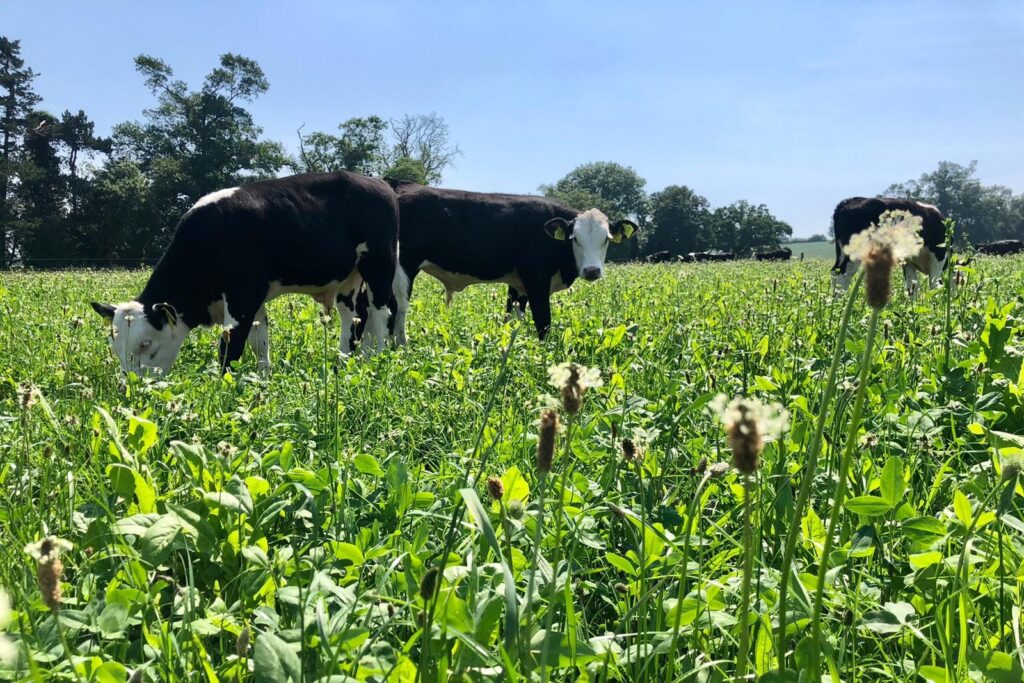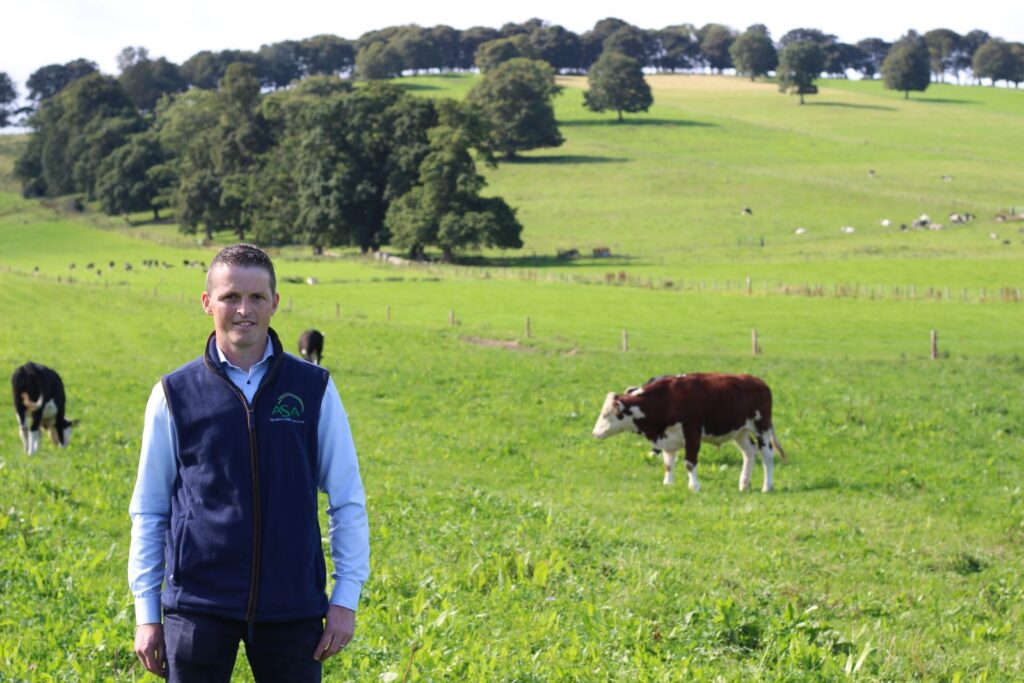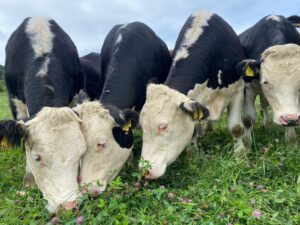Producing more for less: Multispecies swards show exciting potential for livestock sector
30th August 2023
Research carried out by UCD’s School of Agriculture and Food Science has shown that significant cost savings are possible when using multispecies swards for grazing livestock, which can yield up to 25% more herbage and lead to quicker finishing times.

Emerging research by by UCD’s School of Agriculture and Food Science has shown multispecies swards can produce up to 25% more forage for livestock. Photo credit: Dr. Shona Baker
The study, which has been ongoing since 2019, is being conducted at UCD’s Lyons Farm on the Dublin-Kildare border under the supervision of Professor Tommy Boland, who is also president of the Agricultural Science Association (ASA).
Findings so far have revealed that animals grazed on multispecies pastures reach their target slaughter weight five to six weeks earlier than their counterparts grazing perennial ryegrass monoculture, resulting in 15% lower carbon footprint per kg of beef produced.
While the figures may seem startling at first, Professor Boland said results have been highly consistent across the three groups of cattle taken to slaughter in the duration of the study work.
When compared to typical swards sown on most Irish dairy and beef farms, multispecies swards were also found to be much more effective at feeding livestock, with some mixtures producing up to 25% more forage while requiring 60% less nitrogen fertiliser.
If applied to a typical 100-acre farm, this means farmers could grow an additional 100 tonnes of dry matter feed while spreading 4600kg less nitrogen over the course of a single production year, equating to substantial savings on input costs.
In fact, when taking into account the reduced need for concentrate feed during the finishing phase, the net margin per ha was almost 70% higher in the multispecies system compared to the perennial ryegrass system. This suggests farmers can maintain or increase their output levels, while reducing the environmental impact of livestock and increasing profitability.
While the work to date has focused on beef systems, similar findings have been recorded under dairy and sheep management.
“The research into multispecies swards is still in its infancy relative to some of our other sward types, but consistent positive findings show the potential it holds,” Professor Boland said.
“I am confident that when we grow multispecies swards and feed them to beef cattle and sheep, we improve animal performance, and we grow that feed from substantially lower levels of fertiliser inputs and as a result increase farm profitability.”

Professor Tommy Boland
Benefits and limitations
Multispecies swards contain a range of different plant species which have been selected to fulfil various roles or niches within the sward. The study at UCD’s Lyons Farm has focused on investigating three different sward types, which have been selected for various reasons.
“We have a monoculture ryegrass sward, reseeding 205kg of N fertiliser/ha/yr, we have a ryegrass and white clover sward, reseeding 90 kg of N fertiliser/ha/yr, and then our multispecies sward is a six-species sward that contains two grasses (premier ryegrass and timothy), two legumes (red and white clover), and two herbs (chicory and plantain),” Professor Boland explained.
“We have tried a number of different mixtures over the years, and it’s that six-species mixture which has provided us with the best results of the ones we have tried so far,” he added.
Currently, the swards are being direct drilled on study fields every two years, a strategy that has worked well for the climate and soil type of Lyons Farm, Professor Boland said.
A major benefit derived from the inclusion of legumes in the sward is increased nitrogen availability in the soil, as these plants have the ability to capture atmospheric nitrogen and offset the need for artificial fertilisers.

Cattle has performed better and reached finishing weight sooner when grazed on the multispecies sward. Photo credit Fionnuala Godwin
Additional benefits recorded on the multispecies swards include enhanced earthworm diversity and activity, increased water infiltration rates and enhanced invertebrate diversity. Swards containing multiple species were also more persistent under drought conditions and maintained growth for longer compared to monoculture swards.
“One big challenge with the multispecies sward is you have no herbicide option for weed control, so if you get a bad outbreak of weeds which has happened to some farmers around the country, then you have no herbicide option,” Professor Boland pointed out.
However, once the sward is well established, the infiltration of weeds was found to be much lower compared to a monoculture sward, likely because more species mean more competition for certain weeds, making for a more resilient system.
“There are many additional benefits and while we need to continue research into this area, the future direction must also include plans to support farmers who want to use these swards,” the professor said.
“Another tool in the toolbox for farmers”
While the approach is not going to be suitable for every farm, and research needs to continue to test these mixtures in different soil types and under different management and weather conditions, it does address many of the challenges facing modern agriculture.
“Farmers are very engaged with this new research and are very interested in seeing the benefits it can have for their farm,” Professor Boland said.
However, he added it will take some time for this new approach to flow through the system, as only around 7% of the grassland area in Ireland is reseeded annually, and the area currently under multispecies swards is quite small, although increasing at a steady rate.
The professor went on to highlight the vital importance of communicating research to farming groups and industry stakeholders to increase confidence in new approaches and the benefits these offer farm businesses.
“Farmers, when they’re investing in this, it has a business impact, but also, they need to be provided with the right management guidelines on how to establish and manage these swards,” he added.
The findings of the research will be presented at the annual Agricultural Science Association conference, taking place on 7th September, with delegates attending from across the Irish agri-food industry, from policymakers to processors to primary producers.
“Ultimately, farmers are the bedrock and the building blocks of our agri-food industry, and really of society in general, and we at the Agricultural Science Association have been very conscious of including farmers in these conversations,” Professor Boland concluded.
